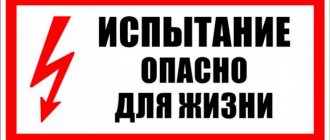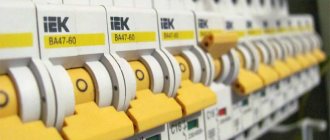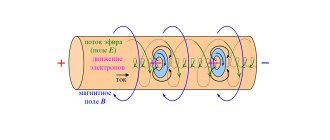Requirements for the symbols and sizes of main and additional safety signs are given in section 6.3 of GOST 12.4.026-2015 “System of Occupational Safety Standards (OSSS). Signal colors, safety signs and signal markings. Purpose and rules of use. General technical requirements and characteristics. Test methods".
Here is a sample of these requirements from section 6.3 of GOST 12.4.026-2015.
In accordance with clause 6.3.2, the geometric shape, signal color, and semantic meaning of the main safety signs must correspond to Table 2.
table 2
Geometric shape, signal color and semantic meaning of the main safety signs
| Group | Geometric shape | Signal color | Semantic meaning |
| Prohibition signs | Circle with a transverse stripe | Red | Prohibition of dangerous behavior or activity |
| Warning signs | Triangle | Yellow | Warning of possible danger. Caution. Attention |
| Mandatory signs | Circle | Blue | Prescription of mandatory actions to avoid danger |
| Fire safety signs* | Square or rectangle | Red | Designation and indication of locations of fire protection equipment and their elements |
| Evacuation signs and signs for medical and sanitary purposes | Square or rectangle | Green | Indication of the direction of movement during evacuation. Rescue, first aid in case of accidents or fires. Inscription, safety information |
| Directional signs | Square or rectangle | Blue | Permission. Note. Inscription or information |
* Fire safety signs also include:
| |||
Difference between signs and posters
The main difference between them is their purpose. In short, the function of signs is to inform about permanent factors, for example, to warn maintenance and repair personnel about the possibility of accidental contact with live structural elements. Accordingly, fixed places are provided for the location of these electrical protective equipment.
ES signs can be made of metal or dielectric materials; it is allowed to paint them or apply a film with a pattern. In the first case, when a metal base is used, the installation is carried out at a safe distance from live elements.
These safety equipment are displayed in accordance with their intended purpose. Unlike signs, they can be permanently located or portable.
Types of posters by purpose
These funds are classified depending on their functional purpose into the following types:
- Prohibiting action , this group imposes a ban on the use of switching equipment to prevent its activation during repair and maintenance work in the area of responsibility.
- Preventive action is prescribed to be installed in places where there is a danger of accidental contact with live parts of an electrical installation, or a danger of approaching them. In addition, this category includes a means that informs about the prohibition of entering the electric field zone without appropriate protective equipment.
- Prescriptive in nature . The purpose of these means is to point maintenance or repair personnel to a specially prepared place that meets safety standards.
- Indicating destination . Currently, GOST provides only one means for this group, informing about the imposition of portable grounding.
Let's look at what products are included in this or that group, the conditions for their use, the accepted format, as well as the acceptable colors. The sequence will be the same as adopted in GOST 12.4.026 2015 (Appendix 9).
Prohibiting
This category includes four types:
- Prohibiting the switching on of switching devices that provide power to electrical installations.
Poster “Do not turn on!
People are working” The design is made in two formats: 100.0 x 50.0 mm and 200.0 x 100.0 mm. The inscription is made in red letters on a white background. The inscription is framed with a frame of the same color as the letters. The edging has a width of 1.25 mm and is made in white.
Electrical safety rules allow the use of these safety equipment regardless of the voltage class of electrical devices. Installation is prescribed in places where switching devices are controlled, providing power supply shutdown. If the circuit diagram of the electrical device does not imply the presence of such switches, the poster is installed on the removed fuses.
- Prohibition on turning on power lines.
Poster “Do not turn on! Work on the line!
The dimensions remain standard (200.0x100.0 and 50.0x100.0). As for the inscription, it is executed inversely to the previous version, that is, in white letters. Accordingly, the colors of the edging and frame change, but their sizes remain the same.
The purpose is the same as the previous poster, adjusted for cable and overhead lines.
- Prohibition on supplying working fluid to the pipeline, opening cylinders, etc.
Poster “Do not open! People are working."
The form factor and color design correspond to the above electrical safety device from paragraph 1. This electrical protective device is installed on shut-off valves in the following cases:
- When it is necessary to prohibit the use of shut-off valves for pneumatic drives of switching devices. An example of such devices is high-voltage switches.
- If it is necessary to prevent the supply of working fluid into pipelines in order to prevent an emergency and ensure the safety of the repair team.
- Prohibition on reactivating the power line switching mode after it has been turned off. This issue must be previously agreed upon with the person responsible for safety.
Poster “Working under voltage. Do not turn it on again"
The dimensions of this type are 100.0 x 50.0 mm. Red letters are used. Installation is carried out on control keys responsible for supplying power to the power lines being repaired. This does not require de-energizing the latter.
Warning
Let's consider the safety equipment of this category, the numbering continues in accordance with Appendix 9 of the above GOST:
- Warning sign indicating possible danger of electric shock.
"Caution Electrical Voltage" sign
The sign has the shape of an equilateral triangle with a black border and a yellow background. Inside the triangle is a stylized lightning bolt. Dimensions may vary within the following limits:
What are there
The distribution of existing signs by groups and types is established by the current labor legislation, as well as instructions from government authorities in the field of labor protection.
One of the mandatory installations is the presence of the required signs directly in the institution. They are applied, placed and explained by the organization’s occupational safety specialist.
Determining the type of sign depends on the working conditions, the premises of the enterprise, and the requirements of the legislator. There are several types, and they differ in the reasons for their use and the information they contain.
The main signs must be classified into groups:
| Type of sign | Special purpose |
| Prohibiting | Contain a ban on dangerous behavior. Emergency situations are not allowed. Designed to warn employees of the institution about the dangers in their work. These are, for example, “Access denied”, “Smoking prohibited”. A special feature is a prohibition on certain actions: movement, use of specific objects. In case of violation of the prohibitions provided for by such signs, the employee may be subject to punishment depending on the severity of the consequences. It is important to pay close attention to these signs in organizations dealing with substances of a dangerous and harmful nature. |
| Warning | Inform about possible danger, call for caution and attention. Warn employees about possible negative consequences that manifest themselves depending on working conditions and the characteristics of the organization’s activities. Inform about the nature of possible risks. Such signs, for example, include warnings about biological threats, poisons, and flammable substances. An employee must be attentive to such signs, because they will protect him from negative consequences. |
| Fire safety | Inform about the places where fire protection equipment is located: hydrants, fire extinguishers, taps, alarm buttons. These signs will indicate the risk of fire, electrical circuit breakage, and provide information about the telephone numbers of emergency services, the procedure for action in the event of a fire or circuit breakage. |
| Prescriptive | They provide for mandatory actions to avoid danger, that is, those that the employee is obliged to take during work in order to prevent a dangerous situation or violation of established safety standards. These include, for example, those that require workers to wear helmets and protective masks. Such signs are mandatory for all workers in a certain area. |
| Evacuation and medical and sanitary purposes | They indicate where to go in case of evacuation, where to seek salvation and first aid. It can be difficult to navigate in a state of danger, and such signs carry a meaning that is understandable at the level of intuition. Employees of the enterprise, when realizing risks, focus on them during the evacuation process. |
| Index fingers | They inform and allow action. They help provide employees with information about the location of the organization’s services, service entrances, exits, smoking areas, and other premises. |
GOST determines the color scheme of elements designed to ensure safe work for employees. This means that each type of element has its own specific color format, which is as comfortable as possible for visual perception and understanding.
All types of elements are depicted in bright colors, but the markings on them should be black or white, which will provide maximum contrast.
Each color has its own format.
According to signal colors they are divided into:
- red;
- yellow;
- green;
- blue.
| Color | Type of sign | Purpose |
| Red | Prohibiting | The most noticeable color emphasizes the danger. Attracts the most attention. An object or action that is prohibited is highlighted in black. Contrasting color - white. |
| Fire safety | It is highlighted with a red background with white indicators. | |
| Yellow | Warning | Indicate possible dangers and risks. They have black edging and black instructions. |
| Green | Evacuation and medical and sanitary purposes | The most comfortable color, having a “friendly” character. Contrasting color - white. |
| Blue | Prescriptive and indicative | A blue background with white guidelines is used. |
Thus, in order to protect employees, GOST specifies in detail both specific colors indicating membership in a particular group of elements, and their external format. The purpose of such detailed description is to make the information as accessible and uniform as possible.
According to their intended purpose, signal colors are used in signs to indicate:
- objects that can become sources of danger (various structures, machines);
- fire fighting equipment and its elements;
- danger signals, signal markings, evacuation plans;
- luminous safety equipment (displays, lamps);
- escape routes.
Labor safety signs are divided into basic, additional, combined and group.
The main ones clearly express the requirement to ensure safety; they can be used independently or included in combined and group ones. For them, the color for the design and the ratio of the included elements are strictly established. Thus, in warning signs the area of yellow color is not less than 50% of the surface, in prohibitory signs the area of red color is not less than 35%.
The additional ones contain an explanatory inscription and provide for their use in combination with the main ones.
Combined and group include basic and additional ones and contain comprehensive requirements to ensure safe operation. The combined use of basic and additional elements is required to provide the most accurate and complete information to employees to ensure the appropriate level of protection for their health. A combined designation can simultaneously prescribe, prohibit and warn. Their distinctive feature is their rectangular shape and white background.
By nature of application
This classification for electrical safety posters and signs allows you to determine whether the device will be installed on a permanent basis or whether it is portable. The first, for the most part, include signs, for example, voltage indicators, which are a triangular information plate with a stylized image of lightning.
Stationary
Of the types listed above, these include the signs given in paragraphs 5 and 6, as well as the warning poster from paragraph 10
Portable
All other posters that were discussed are portable, that is, those that are installed in new places.
It makes sense to create sets of portable posters only when standard maintenance or repair of electrical network components or equipment powered by it is performed. In such cases, you can take a certain number of mandatory, prohibitive or other safety posters and signs, including “danger to life” signs, in advance.
During work with electrical installations and switching equipment, various operations are performed that pose a danger to the health and life of operating personnel. To avoid unauthorized switching on or off of electrical equipment, special electrical safety signs are used, which reflect the possibility or impossibility of certain actions by workers. They are divided into various categories and primarily warn of possible danger when contacting live equipment in electrical installations.
General information about electrical safety signs
Electrical safety posters and signs are produced according to established standards. They are intended for use in various conditions and are divided into several categories:
- Prohibiting . These posters prohibit any actions with switching equipment, the activation of which by mistake may cause voltage to enter the workplace. They also prohibit moving without protective equipment in electrical installations with a voltage of 330 kV or more and an electric field strength of over 5 kV/m.
- Warning . Electrical safety signs in this category warn of possible danger when approaching live parts in electrical installations that are energized.
- Prescriptive . Allow the performance of any actions subject to specific electrical safety requirements.
- Pointing . They indicate the location of certain objects and devices.
In accordance with the nature and characteristics of the application, all graphic images in the field of electrical safety are of permanent or portable type.
For the manufacture of signs and posters, dielectric materials such as getinax, polystyrene, fiberglass, textolite, PVC and others are used. In electrical installations with exposed live parts, it is prohibited to use temporary and portable signs made of conductive materials. They can only be used in electrical installations not directly connected to live parts.
Posters and safety signs are attached to metal or concrete surfaces with great difficulty for technical reasons. Therefore, it is recommended to apply them through a stencil with appropriate paints or stick posters on the basis of self-adhesive film. The paint and varnish materials used must provide a color coating that is resistant to the production and climatic conditions for which they are intended.
In conditions of poor visibility or at night, all signs or posters used must be illuminated in various ways without changing the color or other parameters.
In order to better understand the purpose of each category of posters and signs, they need to be considered in more detail. Their correct and timely use will help protect personnel from accidents and preserve people’s lives and health.
Prohibition posters
The “LOGINE OPERATION DO NOT RE-ON” sign is used to prohibit manual re-closure of overhead line switches after they have been automatically switched off. Such actions must be coordinated with the work manager.
These electrical safety posters must be posted on the control keys included in the overhead line switches. They are hung when performing repair work under voltage. The standard size of the poster is 100x500 mm, with a red border 5 mm wide running along the perimeter. The inscription's letters are red and printed on a white background.
Poster “DO NOT TURN ON! People are working” is figurative. It prohibits applying voltage to the line in all cases. It is hung on buttons, keys and switchgear control drives. When you turn it on, the voltage will definitely get to the line, so this should not be done under any circumstances. These posters are used in electrical installations with voltages not only up to 1000 volts, but also above this value.
The poster dimensions are standard – 100x200 mm, with a perimeter border 5 mm wide. The inscription uses red letters on a white background.
Portable poster “DO NOT TURN ON! operation on the line" prohibits the supply of voltage to the line. It is also hung on the control elements of the switching equipment of electrical panels, when turned on, voltage can be supplied to the line. The inscription is written in white letters on a red background without a border. Overall dimensions are standard – 100x200 mm.
Prohibitory signs “DO NOT OPEN by people working” are also portable. They are hung on valves and gate valves that shut off the air supply to pneumatic switching equipment. An error when opening these devices may cause the equipment on which the work is being performed to turn on. This symbol also applies to gas cylinders, as well as hydrogen or oxygen pipelines, which, if opened, could cause injury to workers with serious negative consequences. The dimensions of the sign are standard; there is a red border around the perimeter.
Warning signs and posters
All maintenance personnel run the risk of approaching dangerous distances from live parts without even knowing it. Warning signs and posters installed near potentially dangerous objects will help to eliminate such situations.
In such cases, the “STOP!” sign is used. voltage”, signaling the danger of contact with electric current. This poster is portable and is used in equipment with a voltage of 1000 volts and other values higher or lower. The standard size is 150x300 mm, the configuration of the red boom is defined in GOST 12.4.026. There is a red border 15 mm wide along the perimeter. The letters of the inscription are black, on a white background.
The “KEEP OUT!” sign performs exactly the same function. will kill."
The "Dangerous TEST" poster clearly states the danger of electric shock during the period when high voltage testing is being carried out. It is installed on the fence of the workplace. Overall dimensions 150x300 mm, a red border 21 mm wide is applied along the perimeter. On a white background there is a red lightning bolt and black letters.
What are provided
Labor protection and safety signs are issued in accordance with the regulations approved by GOST 12.4.026-2015, with uniform requirements for distribution by type, purpose, size, color.
The document details:
- materials from which the signs are to be made,
- rules for using signs on objects.
- special purpose;
- defining features of the signal colors of safety signs;
- appearance;
- size and technical requirements for signs.
GOST fully reflects the system of standards and requirements for ensuring occupational safety.
Mandatory signs
They indicate places of work in electrical installations and indicate safe approaches to these workplaces. Among them, it is often necessary to use a figurative “WORK HERE” sign. In accordance with GOST, they are produced square, with dimensions of 100x100 and 250x250 mm. There is a blue edging 20 or 50 mm wide along the perimeter. The inscription is made in black letters on a white background.
“GET IN HERE” posters, used in cases where the workplace is located at a height, have exactly the same characteristics. At the same time, they are an indicator of the safest route to the desired area. The dimensions correspond to GOST and the previous poster.
Safety sign size ratio
According to clause 6.3.3, the area of safety signs is limited by yellow or white edging. The edging is used to contrast the marks against the surrounding background in places of placement.
In accordance with clause 6.3.3.8, the graphic symbol and explanatory inscription on rectangular safety signs can be placed both horizontally and vertically relative to side b.
According to clause 6.3.3.9, it is allowed to make prohibiting, warning, and mandatory safety signs on the surface of the carrier material, which is shaped like a square. The side of the square must be greater than or equal to:
- circle diameter d for prohibitory and mandatory signs;
- side of the triangle b for warning signs. In this case, the basis of the color graphic image and the ratio of the sizes of safety signs must be in accordance with Figures 1, 2, 3.
Prohibitory safety signs
According to clause 6.3.3.1 of GOST 12.4.026, the basis of the color graphic image and the ratio of the sizes of prohibiting safety signs must correspond to Figure 1.
Picture 1*. The basis of the color graphic image and the ratio of the sizes of prohibiting safety signs (d - diameter of the circle; 1 - main surface; 2 - edging; 3 - border; 4 - transverse stripe)
Primary requirements:
- The share of the red signal color from the total area of the prohibition sign must be at least 35%.
- The red transverse stripe is made at an angle of 45° to the horizontal with a slope from left to top to right to bottom.
- The red transverse stripe must not be interrupted by the graphic symbol of the sign.
- The graphic symbol must be black.
- It is allowed to use prohibition signs with an explanatory inscription in the center of the sign. In this case, the red transverse stripe is not applied. The inscription should be in black or red.
- Codes, color graphics, semantic meanings, placement (installation) locations and recommendations for the use of prohibitory safety signs are established in Appendix E of GOST 12.4.026-2015.
Safety warning signs
According to clause 6.3.3.2, the basis of the color graphic image and the ratio of the sizes of safety warning signs must correspond to Figure 2.
Figure 2 - The basis of the color graphic image and the ratio of the sizes of safety warning signs (b - side of the triangle; 1 - main surface; 2 - edge; 3 - border)
Primary requirements:
- The proportion of yellow signal color from the total area of the sign must be at least 50%.
- The graphic symbol must be black.
- The color of the edging should be yellow or white.
- Codes, color graphics, semantic meanings, placement (installation) locations and recommendations for the use of safety warning signs are established in Appendix Z GOST 12.4.026-2015.
Mandatory safety signs
According to clause 6.3.3.3, the basis of the colorographic image and the ratio of the sizes of the mandatory safety signs must correspond to Figure 3.
Figure 3 - The basis of the colorographic image and the ratio of the sizes of the mandatory safety signs (d - diameter of the circle; 1 - main surface; 2 - edge)
Primary requirements:
- The blue signal color must make up at least 50% of the total area of the sign.
- The graphic symbol of mandatory safety signs must be white.
- Codes, color graphics, semantic meanings, placement (installation) locations and recommendations for the use of prescriptive signs are established in Appendix I GOST 12.4.026-2015.
Fire safety signs
According to clause 6.3.3.4, the basis of the color graphic image and the ratio of the sizes of fire safety signs must correspond to Figure 4.
Figure 4 - The basis of the color graphic image and the ratio of the sizes of fire safety signs (a, b - sides of the square and rectangle (2a=b); 1 - main surface; 2 - edge)
Primary requirements:
- The share of red signal color from the total area of the sign must be at least 50%.
- The graphic symbol of fire safety signs must be white.
- Explanatory notes may be placed on fire safety signs. The inscription can be made in white on a red background or in red on a white background.
- On the left side of the rectangular fire safety sign there should be a graphic symbol indicating the fire protection device (its elements), and on the right side there should be an explanatory inscription.
- Codes, color graphics, semantic meanings, placement (installation) locations and recommendations for the use of fire safety signs are established in Appendix K of GOST 12.4.026-2015.
Evacuation safety signs and safety signs for medical and sanitary purposes
According to clause 6.3.3.5, the basis of the color graphic image and the ratio of the sizes of evacuation safety signs and safety signs for medical and sanitary purposes must correspond to Figure 5.
Figure 5 - The basis of the color graphic image and the ratio of the sizes of evacuation safety signs and safety signs for medical and sanitary purposes (a, b - sides of the square and rectangle (2a = b); 1 - main surface; 2 - edge)
Primary requirements:
- The proportion of green signal color from the total area of the sign must be at least 50%.
- The graphic symbol and explanatory inscription of evacuation safety signs and safety signs for medical and sanitary purposes must be white.
- Codes, color graphics, semantic meanings, placement (installation) locations and recommendations for the use of evacuation signs and signs for medical and sanitary purposes are established in Appendix L of GOST 12.4.026-2015.
Safety signs
According to clause 6.3.3.6, the basis of the color graphic image and the ratio of the sizes of safety signs must correspond to Figure 6.
Figure 6 - The basis of the color graphic image and the ratio of the sizes of safety signs (a, b - sides of the square and rectangle (2a = b); 1 - main surface; 2 - edge)
Primary requirements:
- The proportion of blue signal color from the total area of the sign must be at least 50%.
- The graphic symbol and explanatory text of safety signs must be white.
- Codes, color graphics, semantic meanings, placement (installation) locations and recommendations for the use of safety signs are established in Appendix M GOST 12.4.026-2015.
Additional safety signs
According to clause 6.3.3.7, the basis of the color graphic image and the ratio of the sizes of additional safety signs must correspond to Figure 7.
Figure 7 - The basis of the colorographic image and the ratio of the sizes of additional safety signs (a, b - sides of the square and rectangle (2a = b); 1 - main surface; 2 - edge)
Primary requirements:
- Additional safety signs should be used in combination with the main safety signs and used in cases where it is necessary to clarify, limit or strengthen the effect of the main safety signs, as well as for information.
- Additional safety signs may be located below, or to the right, or to the left of the main safety sign.
- Shape of additional safety signs: rectangle; color of the main surface - corresponding to the color of the main safety sign according to Table 2 or white; border color - black or red; edging color - white or yellow (for the main surface yellow).
- Borders on additional signs with a red, blue or green main surface are not applied.
- It is allowed to make additional signs with a white or yellow main surface without a border.
- The explanatory inscription must be black (for a white or yellow main surface) and white (for a red, blue or green main surface).
Directional posters
A typical representative of this group is the “GROUNDED” sign. It indicates the grounding of a certain section of the electrical installation and the prohibition of the supply of electric current to it.
Its location is usually the drive of the switching equipment. If prohibition and directional posters are used at the same time, the latter should be hung from above. Dimensions according to GOST 100x200 or 50x100 mm, with a corresponding white border width of 13 and 5 mm. The inscription uses white letters located on a blue background.
The sign - CAUTION ELECTRIC VOLTAGE is a warning sign. This sign serves to warn about the danger of electric shock in electrical installations and structures.
This sign has two versions:
Version 1
Version 2
Design and dimensions of the poster CAUTION ELECTRIC VOLTAGE
The sign - CAUTION ELECTRIC VOLTAGE has a standard design and fixed dimensions.
For Execution 1 , the sign is made in accordance with GOST R 12.4.026 (sign W08). The background and edging are yellow, the border and arrow are black. Triangle side: 300 on room doors. For equipment, the sizes vary: 25, 40, 50, 80, 100, 150 mm, respectively.
The sign for Execution 1 is of a permanent nature - it is applied on an ongoing basis for equipment, machines and mechanisms.
For Execution 2 - the dimensions of the sign itself are similar to Execution 1, the border and arrow are applied using a stencil to the concrete surface with indelible black paint. The background is the concrete surface. The sign for Execution 2 is permanent.
Scope of application of the poster CAUTION ELECTRIC VOLTAGE
Sign “CAUTION ELECTRIC VOLTAGE” - Version 1, installed in electrical installations up to and above 1000 V in power plants and substations. It is fixed on the outside of the entrance doors of the switchgear (with the exception of the doors of the switchgear and transformer stations located in these devices); external doors of chambers of switches and transformers; fencing of live parts located in production premises; doors of switchboards, control cabinets and assemblies with voltage up to 1000 V.
In populated areas*. It is fixed on the supports of overhead lines above 1000 V at a height of 2.5-3 m from the ground, for spans of less than 100 m it is strengthened through a support, over 100 m and crossings across the road - on each support. When crossing the road, the signs should be facing the road, in other cases - on the side of the support, alternately on the right and left sides. Posters are mounted on metal and wooden supports.
* Populated area - the territory of cities, towns, villages, industrial and agricultural enterprises, ports, marinas, railway stations, public parks, boulevards, beaches within the boundaries of their long-term development for 10 years.
The sign “CAUTION ELECTRIC VOLTAGE” - Version 2, is applied on reinforced concrete supports of overhead lines and outdoor switchgear fences made of concrete slabs.
GOST 12.4.026-2015
1 area of use…………………………………………………………
2 Normative references…………………………………………………………
3 Terms and definitions……………………………………………………..
4 General provisions…………………………………………………………….
5 Signal colors…………………………………………………………….
6 Safety signs………………………………………………………..
7 Signal markings…………………………………………………………
8 General technical requirements………………………………………………………………
9 Safety requirements determined by the design
execution and materials used…………………………..
10 Acceptance rules……………………………………………………………..
11 Test methods………………………………………………………………………………
12 Marking, packaging, transportation and storage of signs
safety and signal markings……………………………………..
13 Manufacturer's guarantee……………………………………………………….
Appendix A (mandatory) Definition of colorimetric and
photometric characteristics of signal and contrast colors, non-luminous and retroreflective safety signs and signal markings and materials for them
manufacturing……………………………………………………………………………………….
Appendix B (mandatory) Definition of colorimetric
characteristics of photoluminescent safety signs,
signal markings and materials for their production…….
Appendix B (recommended) Conditions for selecting and reproducing non-luminous materials of signal and contrasting colors Appendix D (mandatory) Determination of photometric characteristics of photoluminescent safety signs and signal
markings at the operational stage……………………………………
Appendix E (mandatory) Measurement of photometric characteristics of photoluminescent safety signs and signal markings and materials for their manufacture in the laboratory...
Appendix E (mandatory) Prohibition signs………………………………
Appendix G (mandatory) Warning signs………………………..
Appendix I (mandatory) Mandatory signs………………………….
Appendix K (mandatory) Fire safety signs…………………..
Appendix L (mandatory) Evacuation signs and medical and
sanitary purposes……………………………………………………….
Appendix M (mandatory) Indicative signs……………………………….
Appendix H (mandatory) Shape and dimensions of the graphic symbol
electrical voltage……………………………………………………………
Appendix P (mandatory) Marking of images of main signs
security……………………………………………………..
Appendix P (recommended) Fonts for explanatory notes………………
Bibliography…………………………………………………………………………….
IV
GOST 12.4.026-2015
INTERSTATE STANDARD System of occupational safety standards SIGNAL COLORS, SAFETY SIGNS AND SIGNAL MARKINGS
Purpose and rules of use.
General technical requirements and characteristics.
Test methods
System of standards for occupational safety.
Safety colours, safety signs and signal marking.
Purpose and rules of application. General technical requirements and characteristics. _Methods of tests_
Date of introduction - 2016 - —
1 area of use
This standard applies to signal colors, safety signs and signal markings for industrial, public and other economic activities of people, industrial, public facilities and other places where safety is necessary. The standard was developed to prevent accidents, reduce injuries and occupational diseases, eliminate danger to life, harm to human health, and the risk of fires or accidents.
The standard does not apply:
— on the colors used for light signaling of all types of transport, vehicles and road traffic;
— colors, signs and markings of cylinders, pipelines, containers for storing and transporting gases and liquids;
— road signs and markings, track and signal signs of railways, signs to ensure traffic safety of all types of transport (except for safety signs for lifting and transport mechanisms, in-plant, passenger and public transport);
— signs and markings of dangerous goods, cargo units requiring special conditions of transportation and storage;
— signs for electrical engineering.
The standard states:
— purpose, rules of application and characteristics of signal colors;
Official publication
- purpose, rules of application, types and designs, colorographic
image, dimensions, technical requirements and characteristics, test methods for safety signs;
- purpose, rules of application, types and designs, colorographic
image, dimensions, technical requirements and characteristics, test methods for signal markings.
This standard uses references to the following interstate standards:
GOST 8.332-2013 State system for ensuring the uniformity of measurements. Light measurements. Values of relative spectral luminous efficiency of monochromatic radiation for daytime vision. General provisions
GOST 9.403-80 Paint and varnish coatings. Test methods for resistance to static effects of liquids.
GOST 12.1.018-86 System of occupational safety standards. Fire and explosion safety of static electricity. General requirements
GOST 12.1.044-89 (ISO 4589-84) System of occupational safety standards. Fire and explosion hazard of substances and materials. Nomenclature of indicators and methods for their determination
GOST 12.4.040-78 System of occupational safety standards. Production equipment controls. Designations
GOST 427-75 Measuring ruler. Technical specifications GOST 7721-89 Light sources for color measurements. Types. Technical requirements. Marking
GOST 9733.3-83 Textile materials. Test method for color fastness to light under artificial lighting conditions (xenon lamp)
GOST 14192-96 Marking of cargo
GOST 15140-78 Paint and varnish materials. Methods for determining adhesion GOST 15150-69 Machines, instruments and other technical products. Versions for different climatic regions. Categories, operating, storage and transportation conditions regarding the impact of environmental climatic factors
GOST 17677-82 (IEC598-1-86, IEC598-2-1-79, IEC598-2-2-79, IEC598-2-4-79, IEC598-2-19-81) Lamps. General technical conditions
2
GOST 12.4.026-2015
GOST 17925-72 Radiation hazard sign
GOST 18321-73 Statistical quality control. Methods for random selection of samples of piece goods
GOST 18620-86 Electrical products. Marking GOST 19433-88 Dangerous goods. Classification and marking GOST 19822-88 Industrial containers. Technical specifications GOST 20477-86 Polyethylene tape with a sticky layer. Technical specifications GOST 23198-94 Electric lamps. Methods for measuring spectral and color characteristics
GOST 23216-78 Electrical products. Storage, transportation, temporary anti-corrosion protection and packaging. General requirements and test methods
GOST 24940-96 Buildings and structures. Methods for measuring illumination GOST 26824-2010 Buildings and structures. Methods for measuring brightness GOST 29319-92 (ISO 3668-76) Paint and varnish materials. Visual color comparison method
GOST 30402-96 Construction materials. Flammability test method
Note - When using this standard, it is advisable to check the validity of the reference standards in the public information system - on the official website of the Federal Agency for Technical Regulation and Metrology on the Internet or using the annual information index “National Standards”, which was published as of January 1 of the current year , and according to the releases of the monthly information index “National Standards” for the current year. If the reference standard is replaced (changed), then when using this standard you should be guided by the replacing (changed) standard. If the reference standard is canceled without replacement, then the provision in which a reference is made to it is applied in the part that does not affect this reference.









